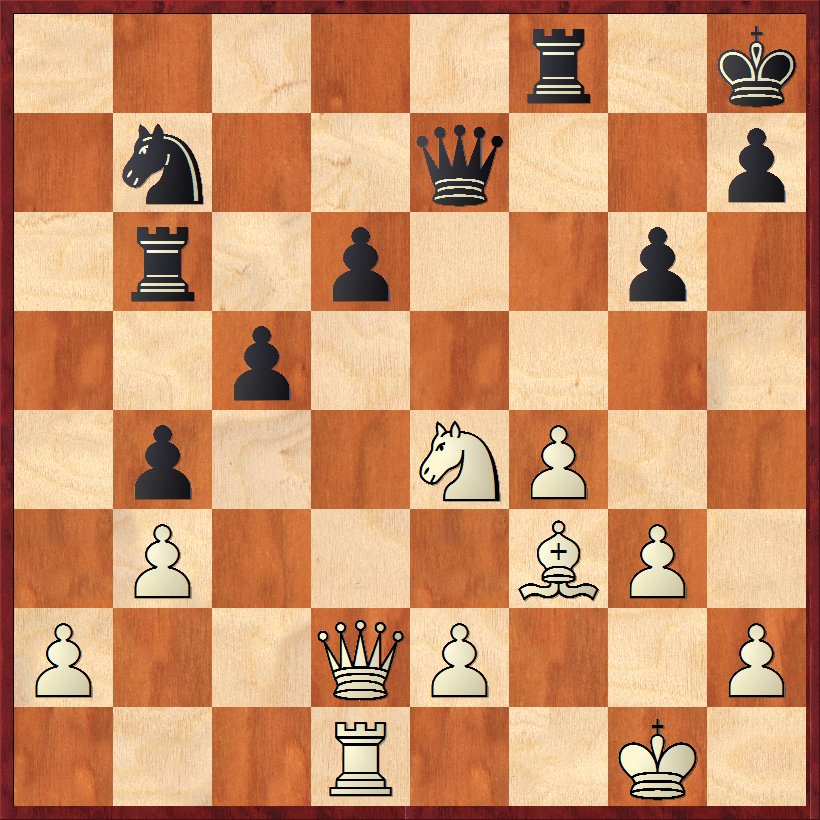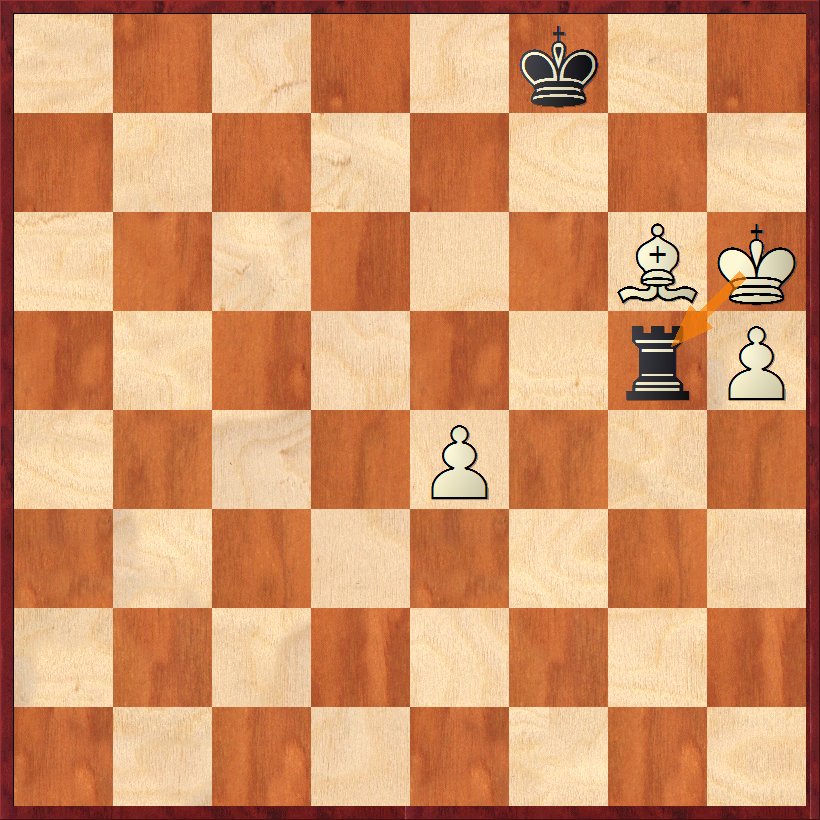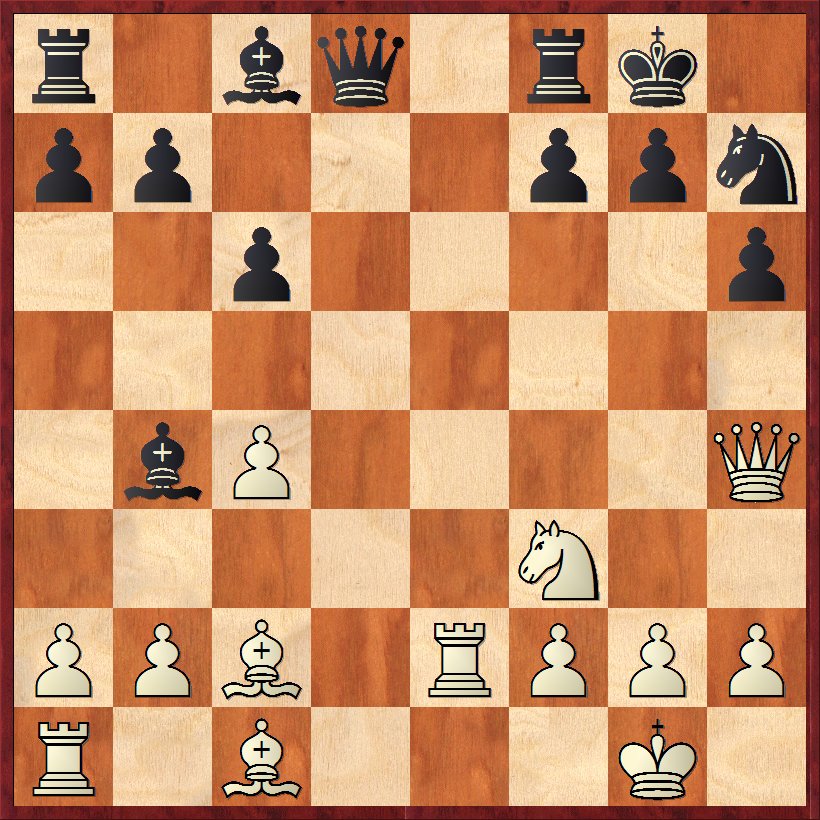|
(1) Gaprindashvili,Nona - Rothuis,Vincent [E66]
Another explosive round! Apart from all the fireworks on the board, this day was somewhat stained by an unpleasant time-trouble incident in the important game Hendriks-Simutowe. This was at the same time the most spectacular game of the day, possibly of the entire tournament. And it also made clear that Simutowe is out to win this event literally by all means.
But of course, the first spectacle we were offered occurred in today's Rothuis game. This time his opponent caused it, albeit after a considerable provocation by the youth player.
Gaprindashvili - Rothuis

19...Bd5?! Commentator Herman van Riemsdijk preferred 19...Bxe4 20.Bxe4 d5, after which Black would be fine. The text rather explicitly invites a sacrifice. 20.Rxd5! And this is the correct sacrifice. 20.Nxd6 Rxd6 21.e4 Bxb3! loses, as well as 20.Nxc5 Bxg2 21.Nxe6 Qa8! 20...exd5 21.Qxd5+ Kh8 After 21...Kg7? 22.Ng5 Black must return the exchange immediately. Now the white position remains a treat to the eye, but somehow Black holds on. 22.Rd1 Nb7 23.f4 Qe7 24.Qd2 b4 25.Bf3

25...d5!? An attempt to free himself by force. White cannot capture: 26.Qxd5 Rd8 27.Qe5+ Qxe5 28.Rxd8+ Nxd8 29.fxe5 is somewhat better for Black, and she does not want to allow a pawn on d4 either, and so we entered an endgame with 26.Qb2+ Qg7 27.Qxg7+. With bishop plus three pawns against rook, White retained the upper hand, but the balance was not tipped definitely and with a standard trick Rothuis gained his first half point.

You will see it coming: wrong rook's pawn. 52...Re5 53.Bf5 Rxe4 and finally Rothuis got rid of his ugly zero. And with a good and interesting game at that.
Dibyendu Barua kept on track by quietly awaiting his chances against the optimistic Fridrik Olafsson.
Olafsson - Barua

12...Bb4 After the game Olafsson recounted that the Belgian grandmaster Alberic O'Kelly de Galway had played 12...exd4 13.Qxd4 Bc5 against him in the Varna Olympiad, 1962. The Icelander had won this game as follows: 14.Qf4 Nf6 15.h3 Be6 16.b3! (on the long diagonal the bishop would become a deadly force) 16...Bd6 17.Qh4 Nd7 and now the pretty 18.Bg5! Qa5 19.Bxh6! and Black immediately resigned. Clearly Olafsson wanted something similar to happen in this game. There's nothing wrong with his memory...
By the way, Herman van Riemsdijk noted that none of the paired players in this round of our tournament had ever played each other before! After the first round, Olafsson and Gaprindashvili had already told us that they had played only once - in 1964. ‘And now we will have to play again soon!', Olafsson claimed after his loss.
13.Re2 exd4 14.Qxd4 Nf6 15.Qh4 Nh7!?

Quite an original move. Now, e.g. 16.Bxh7+ Kxh7 17.Bg5 Qd3 does not bring White anything, and neither does 16.Ng5?? Nxg5 17.Bxg5 Qxg5. Olafsson reacts adequately. 16.Qg3 Bd6 17.Ne5 Qf6 18.Bf4!? After the game Olafsson thought that 18.Bd2 with the idea of Bc3 was better. 18...Rd8 19.h4 Nf8! 20.Rae1!? Not so bad, but White could have maintained the initiative with 20.Rd1, e.g. 20...Bf5 21.Rxd6 Rxd6 22.Nxf7! 20...Ne6

21.Bc1? This fails tactically. 21.Ng6! was still possible, since after the exchanges on f4 White is threatening mate on e8. In the post-game analysis the conclusion was that 21.Qd3 Qxf4 22.Qh7+ Kf8 23.Qh8+ Ke7 24.Ng6+ fxg6 25.Qxg7+ Qf7 yields White nothing either. It is also too late for 21.Bd2, not because of 21...Nd4 22.Bc3 but because of 21...Bxe5!, winning a piece. 21...Nd4! 22.Bg5 hxg5 23.hxg5 Qe6 'Swindler' Olafsson was still silently hoping for 23...Nxe2+ 24.Rxe2 Bxe5? 25.Rxe5 Qd6?? 26.Re8+. 24.Qh4 Nxe2+ 25.Rxe2 Bxe5 26.Qh7+ Kf8 0-1
But the showpiece of the day was in all respects the Hendriks-Simutowe game. In the Dutch Championship last June, Hendriks already showed that he is a difficult opponent for tournament leaders (he almost beat Sergey Tiviakov and held runner-up Daniel Stellwagen to a draw). Against the Zambian he also put up a hell of a fight.
Hendriks - Simutowe

17.Bxh6!? gxh6 18.Be3!? The question remains if 18.Qxh6 would have been a better chance: 18...Bf8 19.Qg5+ Bg7 20.Re3. Now the analyses in the commentary room, with Gaprindahvili, Panno and Rothuis among the spectators, concentrated on 20...Nfd5, e.g. 21.Bh7+ Kf8 22.Rf3 f5 23.Qh5 Re7 and now 24.Ng6+ Kf7 25.Ne5+ is perpetual check. Or also 21.Qh5!? Bxe5 22.dxe5! (after 22.Rxe5, 22...Df6 defends everything) 22...Nxe3 23.fxe3 and again Black cannot prevent the perpetual, as his king cannot cross the d-file. Better for Black appears to be 20...Nd7! 21.Bh7+ (after 21.Qh5 Nxe5 22.dxe5 Rc4! 23.Rg3 Qh4 Black also has more defensive resources) 21...Kf8 and now 22.Rf3 is not on. 18...Nh5 19.g4? Bg5! The computer prefers 19...Nf4 or 19...Ng7, but with the text Black can force a favourable endgame. And Simutowe has proved more than once that he knows quite well how to handle the endgame. 20.gxh5 Bxe3 21.Qxe3 Qg5+ 22.Qxg5+ hxg5

23.h4! White's only chance to create complications. 23...gxh4 24.Kh2 Kf8 25.Rg1!? Nc6! 26.h6! Nxd4!? Simutowe later called this a mistake. He preferred 26...Nxe5 to avoid complications, but it would have been very hard for Black to make progress after, for example, 27.dxe5 Ke7 28.h7 Rh8 29.Kh3 b4 30.Na4. 27.Be4! Bd5 Wrong would be 27...Bxe4? 28.Nxe4 Ke7 29.Rg7 and White wins. In the commentary room 28...Nf5 29.h7 Ke7 appeared on the board.

(analysis diagram)
Herman van Riemsdijk demonstrated the exceptionally beautiful trick 30.Rg8 Rxg8 31.Nc6+!!, but immediately gave the refutation as well: 31...Kf8!. Still there turns out to be a fantastic win for White in this position: 30.Rd1!! and Black cannot prevent mate along the seventh rank and promotion at the same time, see: 30...Rcd8 31.Nc6+; 30...Red8 31.h8Q! Rxh8 32.Rd7+ Kf8 33.Rxf7+ Ke8 34.Nf6+ Kd8 35.Rd7 mate; or 30...Rh8 31.Rd7+ Kf8 32.Rxf7+ Ke8 33.Nf6+ Kd8 34.Rd7 mate.

28.Rg7? Missing the win that could have been achieved by 28.Bxd5! exd5? (28...b4 29.Bb7 Rc7 30.h7!) 29.Nxd5, and 29...Rxe5 is not possible in view of 30.h7. 28...Ke7 29.Rxf7+ Kd6 30.f4 Re7 31.h7 Nc6 32.Rxe7 Good - but even more powerful was 32.Nxd5 exd5 33.Bf5 Rh8 34.Rf6+. 32...Nxe7 33.Nf7+ Kc5 34.Bxd5!? Nxd5?

35.h8D? All these moves were made in raging time-trouble. White should have exchanged Black's knight; after 35.Nxd5! exd5 (35...Kxd5 36.Kh3 e5 (36...Ke4?? 37.Nd6+) 37.f5!) 36.f5! d4 37.h8Q Rxh8 38.Nxh8 d3 39.f6 Kd6 40.f7 Ke7 41.Ng6+ Kxf7 42.Ne5+ Kf6 43.Nxd3 the endgame is won. 35...Rxh8 36.Nxh8 Nxf4 37.Nf7 Nd3 38.b3 Kb4 Somewhere around here the time-trouble incident took place. Simutowe twice asked arbiter Huub Blom in Hendriks's time how many moves he had to make before the time control (according to a spectator he asked ‘Forty?' twice). Both players only had a few seconds to go. Of course Blom did not reply. According to Hendriks something like two moves had to be made, which would mean the incident took place around this move. Simutowe later recounted that at that moment he had less time than his opponent, and that he had not asked his question until move 42. Hendriks stopped the clock and asked for a penalty. But since a time penalty would have ended the game immediately (of course, assuming that forty moves had not been made yet), Blom told the players to play on. Hendriks was furious, but the game went on and the Dutchman lost: 39.Ne4 Ka3 and now White's remaining pawns fell, after which his extra knight could not rescue him.
A sad conclusion for Hendriks and a stain on this wonderful tournament.
Bianca Muhren was captured by the experimental atmosphere. Against Helgi Dam Ziska, in a Fischer-Najdorf she pushed e4-e5 (too?) quickly and according to Ziska the knight sac that followed was also too optimistic. He was proven right; in the endgame the extra piece was duly converted.
Oscar Panno and Puchen Wang remained very quiet amidst the mayhem and agreed a draw after 23 not very spectacular moves.
|
 Daily reports
Daily reports  4. By all means
4. By all means